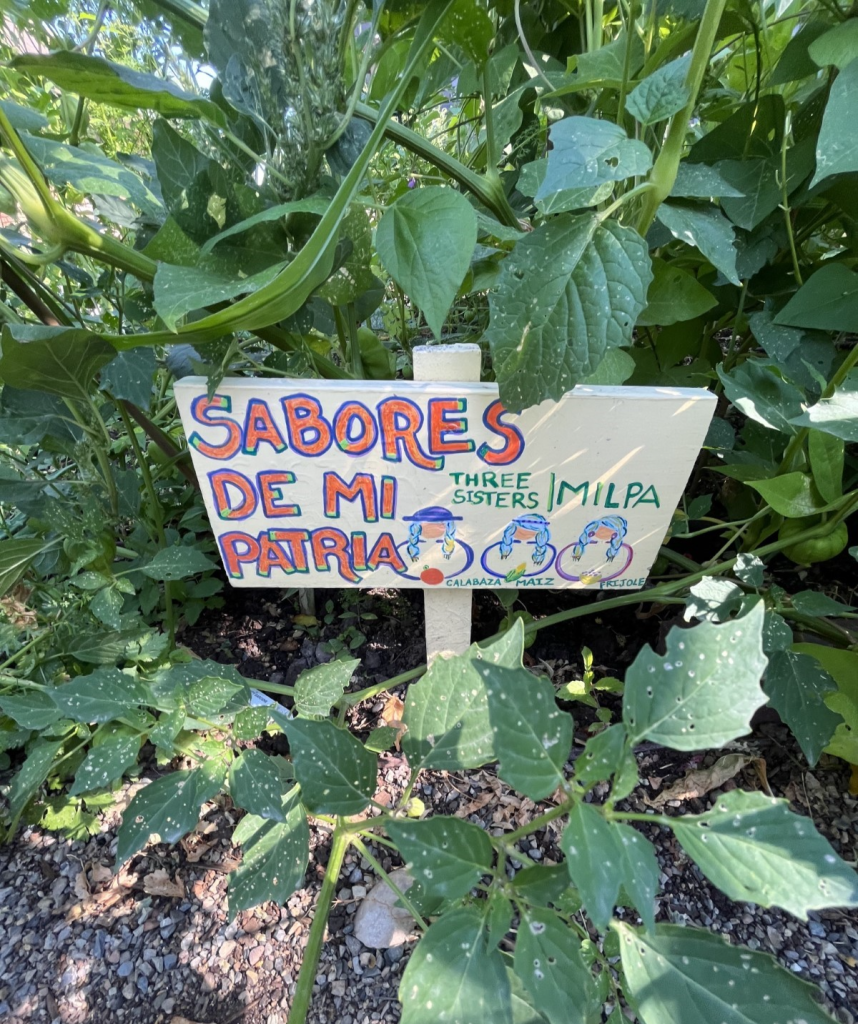Sabores de Mi Patria: Sharing Traditional Gardening Practices with the Community
By SLCgreen Intern Emma Johnson

In mid-July, Wasatch Community Gardens is filled to the brim with lush green vegetable plants, vibrant swaths of flowers, and stooping trees laden with fruit. It is mostly organized into neat sections and rows, but a verdant patch on the southeast edge, boasting many different textures and massive sunflowers reaching to the sky, is more freeform.
This is the Growing Traditions section of the garden, designed for the Sabores de Mi Patria program with Artes de Mexico en Utah to represent traditional agricultural practices from Mexico and other parts of Latin America. Sabores de Mi Patria translates to “flavors of my homeland.”
La Milpa
Vicky Lowe and Kimberly Yapias, who run the garden and the Artes de Mexico en Utah (AMU) programming, explained why the combination of plants they chose is significant. The network of plants growing together is known as a Milpa, a word from the indigenous Nahuatl language.
Lowe, the program director for AMU, explained that la milpa gives people “a sustainable way to have a balanced diet,” providing “everything you need for a nutritious meal every day.” A central part of this network often consists of the three sisters: maíz, calabaza, y frijoles (corn, squash, and beans). Depending on the growing conditions of a geographical region, it can also include chili peppers, tomatoes, tomatillos, and amaranth, which are all present in the Growing Traditions plot.

La milpa is so important because it represents culture, tradition, and pride in one’s food, even amidst racism and discrimination.
“It’s more than just growing food, it’s growing your identity; it’s more than just taking care of the plants, it’s taking care of who you are, and embracing everything that comes with it,” said Lowe.
Program Outline
Artes de Mexico en Utah and Wasatch Community Gardens have been collaborating to share this knowledge and support with the community for five years, in the form of a three part workshop series during the growing season. “Every workshop is always a little bit different and special,” said Yapias, Wasatch Community Garden’s Family and School Garden Manager.

The first workshop occurs in May, and it involves planting seeds and blessing them. The second workshop, in July, is about cooking food from the garden together; last month, participants made different salsas, tamales, calabacitas (a dish made with squash), and quelites (edible wild greens). The third workshop will be held in September and will go through the process of harvesting more of the garden and wrapping it up for the fall.
Yapias explained these workshops are designed for community members of all ages, as many as can fit in the designated space. The events usually draw around 30-50 participants, many of which are families.
Families as Teachers
The number of families participating inspired the program directors to create a cohort called Families as Teachers, which is new this year and is where a large portion of SLCgreen’s microgrant funding will go. In this program, families meet on a few different Saturdays before each workshop to help garden and learn additional skills with a smaller group. Yapias described how sharing knowledge specifically with families is so meaningful because it helps connect families to each other and their heritage.

“We get a lot of comments from folks who maybe grew up in Utah, but their families came from another place of culture. They love this workshop because they feel like they’re getting reconnected to the culture their families are from,” explained Yapias.
For Lowe, managing this program has personal significance. She remembers helping her grandparents care for their garden in southern Mexico, and now enjoys sharing that knowledge with new young people and community members.
Why It’s Important
Many of the families that participate in Sabores de Mi Patria and Families as Teachers identify as indigenous from various different parts of Latin America. Lowe explained how growing la milpa can help them celebrate this rich cultural identity, which is complicated for so many amidst pressure of white assimilation.
Because people’s identities and relationships to food can exist in many different ways, the main goal of these gardening programs is to transmit knowledge into communities for people to use in whatever format they like. Many families who participate in these programs are active in local community gardens and school gardens, helping continue to share the power of growing their own food.
“We want to let people know that we’re here for them,” said Yapias. Yapias and Lowe also collaborate with several community gardens and school groups to help support traditional gardens, including one in Glendale.
This program collaboration between Wasatch Community Gardens and Artes de Mexico en Utah has operated in its most recent form for five years, with the Growing Traditions plot existing for two. With energy from the new Families as Teachers program, financial support from the food equity microgrant, and continued community engagement, hopefully, the program will continue for many more years to come.



